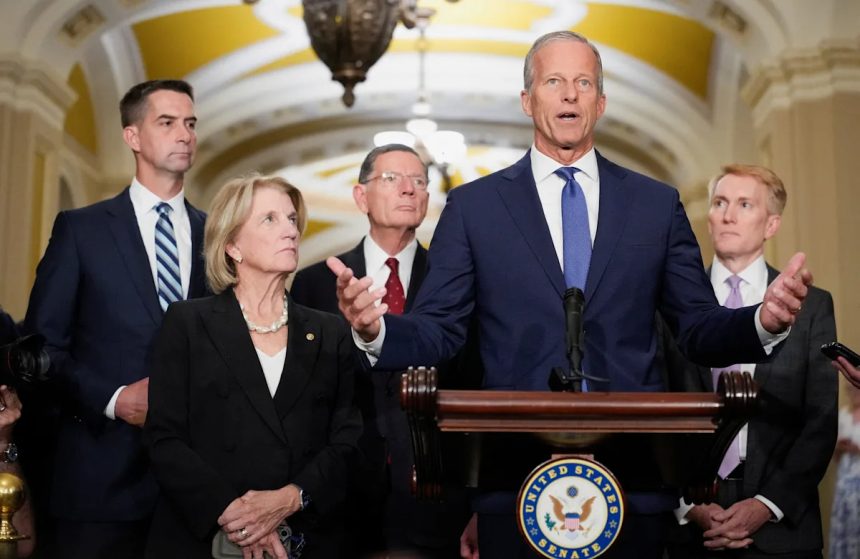Cars are flooded in Petersburg, Va., in July. Many of the canceled federal contracts that have contributed to job losses in the state involved flooding control. (Photo courtesy of Petersburg Fire Rescue & Emergency Services)
Virginia and New Jersey may be among the states most affected by the hiring slowdown that enraged President Donald Trump when it appeared in an Aug. 1 jobs report showing the United States had 258,000 fewer jobs than initially reported in May and June.
Such revisions to earlier reports are based on more up-to-date payroll data and are routine. But the scale in this case was shocking — showing the smallest monthly job gains since pandemic-era December 2020 and the largest jobs revision, outside recessions, since 1968.
In response, Trump declared the numbers were wrong, fired the Bureau of Labor Statistics chief, and offered as a replacement E.J. Antoni, a loyalist who has proposed suspending the jobs report. Trump falsely said in a Truth Social post that the revised jobs numbers were “RIGGED in order to make the Republicans, and ME, look bad.”
Beyond those attention-grabbing actions, though, the numbers demonstrate the real effects of Trump’s work slashing the federal government.
A Stateline analysis of the data shows how several states, especially Virginia and New Jersey, shed jobs in the second quarter of this year, which includes May and June.
In Virginia, there were job losses blamed on canceled federal contracts in Northern Virginia as part of cuts made by Elon Musk’s Department of Government Efficiency, known as DOGE. Meanwhile, a slow housing market shuttered a plywood factory in the southern part of the state, and DOGE efforts canceled flooding control contracts on the coast.
Jay Ford, Virginia policy manager at the Chesapeake Bay Foundation, told a state legislative committee in June that $50 million in contracts were slashed in the Hampton Roads area near the coast, causing a spike in unemployment claims.
That included $20 million to address flooding in Hampton, where almost a quarter of homes are in flood zones, and $24 million to repair a Portsmouth dam that could fail in a major storm, he said.
“This is work that you desperately needed,” Ford said at the committee hearing. “There was a real focus on certain buzzwords like ‘climate’ or ‘resilience,’ and I think people conflated some of these projects as somehow unnecessary.”
For instance, the American Institutes for Research announced 233 layoffs in Virginia in May and 50 in Maryland since the beginning of the year. The not-for-profit organization’s projects include working with school districts to solve achievement gaps and absenteeism, creating AI-driven workforce training, and addressing health care issues such as improving kidney disease care while reducing Medicare costs and strengthening access to health care by keeping rural hospitals open.
“The changes occurring in the federal government have brought significant challenges for many federal contractors, including AIR,” said Dana Tofig, the company’s spokesperson.
Other recent layoffs in Virginia: 442 workers at Northern Virginia’s Mitre, which manages federally funded defense research centers and faced $28 million in canceled federal contracts; and 554 workers at a shuttered plywood factory in Southern Virginia.
“Housing affordability challenges and a 30-year low in existing home sales are impacting our plywood business, as many of our plywood products are used in repair and remodel projects, which often occur when homes change ownership,” Georgia-Pacific said in a May news release.
Stateline looked at two state jobs surveys for the second quarter that sometimes have quite different results: the so-called payroll survey of businesses that the Bureau of Labor Statistics uses for its monthly report, which has yet to be revised at the state level, and the BLS Local Area Unemployment Statistics program, which estimates job changes based on monthly household surveys.
The LAUS estimates are often called the “household” survey because they rely mostly on surveys of households, asking how many people are employed. They include jobs the payroll survey can’t get, such as contract and agricultural jobs, and capture jobs where people live rather than states where employers are located.
In a state like Virginia with a high number of federal employees and contract workers, lost jobs may show up sooner in the household survey since many federal jobs are not reflected on state-level payrolls if they are done by subcontractors, if the agency or contractor is based in another state, or if DOGE cuts allowed people to stop work but stay on the payroll until September. Those people might report being unemployed in the household survey but wouldn’t show up in other surveys until October.
The household survey shows about the same number of slowing job gains as the revised national payroll report, so it may be a window into the trends, many caused by Trump administration cuts in government, health care and foreign aid, and also by slowing sales in stores and housing markets.
Both surveys rely on small samples and are often revised later, said Charles Gascon, an economist and research officer at the Federal Reserve Bank of St. Louis. The more definitive Quarterly Census of Employment and Wages, set for release Dec. 3 for the second quarter, will show state patterns more conclusively, he said.
The household surveys show Virginia with the largest job losses in the country for the second quarter, down about 43,000, and job losses every month since February. Before that, the state gained jobs every month since the height of pandemic job losses in April 2020.
New Jersey, which had the most job losses — 15,400 — in the separate second-quarter payroll survey, has suffered layoffs in retail stores hit by a slowdown in consumer spending, increased shoplifting and, among drugstores, lawsuits for their role in the opioid epidemic.
Walmart announced 481 layoffs at its Hoboken, New Jersey, corporate office, and Rite Aid drugstores laid off 1,122 amid Chapter 11 bankruptcy affected by opioid crisis lawsuits that also hit Walmart and other pharmacy chains. Pharma firms Bristol Myers Squibb and Novartis also have announced hundreds of layoffs in New Jersey, citing patent expirations on popular drugs.
Wobbly state finances
Rising unemployment combined with weak revenue growth suggests “economic fragility” for state finances, said Lucy Dadayan, a principal research associate for the Urban-Brookings Tax Policy Center who tracks state tax revenue.
Nationally, unemployment was at 4.2% in July, the same as July 2024 but up from recent lows of 3.4% in April 2023, with the largest increases in Mississippi, Virginia and Oregon.
Unemployment has dropped the most compared with July 2024 in Indiana, Illinois, New York and West Virginia.
The states with the highest unemployment rates in July were California (5.5%), Nevada (5.4%) and Michigan (5.3%), while the lowest were in South Dakota (1.9%), North Dakota (2.5%) and Vermont (2.6%).
“I think the dramatic May and June jobs revision signals economic fragility. State-level warning signs suggest the impacts will show gradually,” Dadayan said. “And of course states are facing fiscal challenges caused by One Big Beautiful Bill Act tax and spending decisions.”
State finances are a mixed picture, with income tax collections rising because of a strong stock market and sales tax growth weak as consumers retreat on spending, Dadayan said.
State layoff figures are giving us an early read.
– Amanda Goodall, a workforce analyst known as “The Job Chick” on social media
In Virginia, the economically distressed area around Emporia will suffer aftershocks from the plywood plant closing, said Del. Otto Wachsmann, a Republican who represents the area in the state House of Delegates. The area is already reeling from the indefinite closure of a nearby Boar’s Head lunch meat plant that employed 600 people after a listeria outbreak there last year.
The community, part of the southern “Wood Basket” region, has a large logging industry that will now struggle to find new markets farther away with higher costs for trucking, Wachsmann said. “We’re working hard to find new industries to come here.”
Layoff rates in April, as calculated by the online human resources platform Techr, showed New Jersey, Vermont and Virginia with the highest rates.
Amanda Goodall, a workforce analyst who calls herself “The Job Chick” on social media, said the layoffs reflect restructuring in major corporations as well as federal cutbacks. She wrote about the layoff rates in a recent post.
“These are not statistical flukes. They reflect real corporate moves, in New Jersey and Virginia especially,” Goodall wrote in an emailed statement to Stateline. “The bigger issue is that nobody on the ground cares what the unemployment rate says if they can’t find an interview for a job they’re qualified for. State layoff figures are giving us an early read.”
California and Texas
California and Texas saw the biggest jobs gains in both surveys in the second quarter.
Texas added 42,700 jobs in the payroll survey, with the largest increase coming in the category of private educational services, 14,400 jobs, as the state approved a plan for school vouchers to start next year, according to a statement to Stateline from the Texas Workforce Commission.
California added 25,300 jobs. But the household survey showed an increase of almost 111,000 jobs, the highest in the country.
A Public Policy Institute of California blog post in July called the state’s labor market “at best, in a hold-steady pattern this year,” citing the state’s stubbornly elevated unemployment rate of 5.4% but also its jobs improvement over last year.
“A hold-steady pattern is a welcome change from a year ago,” said the post, written by Sarah Bohn, a senior fellow at the institute.
Stateline reporter Tim Henderson can be reached at thenderson@stateline.org.












